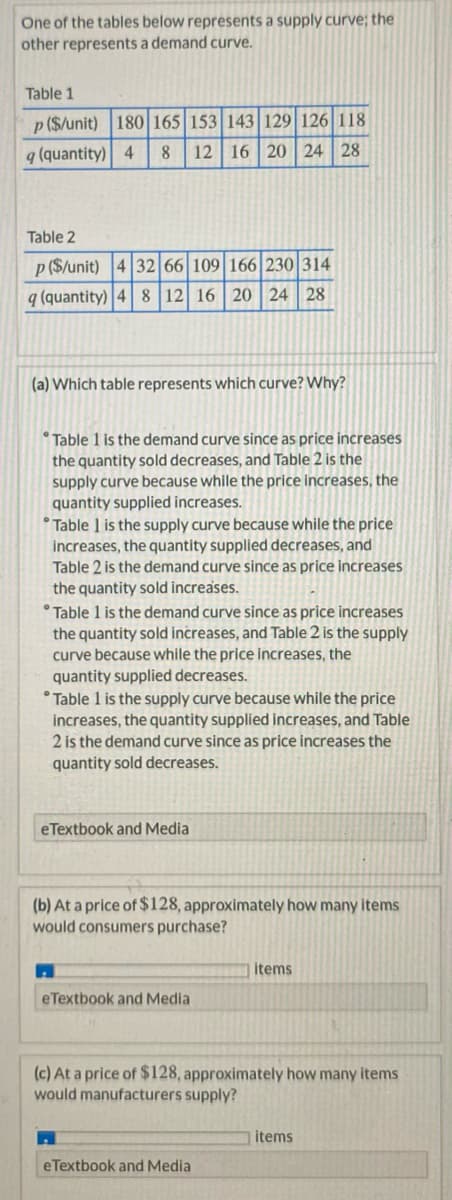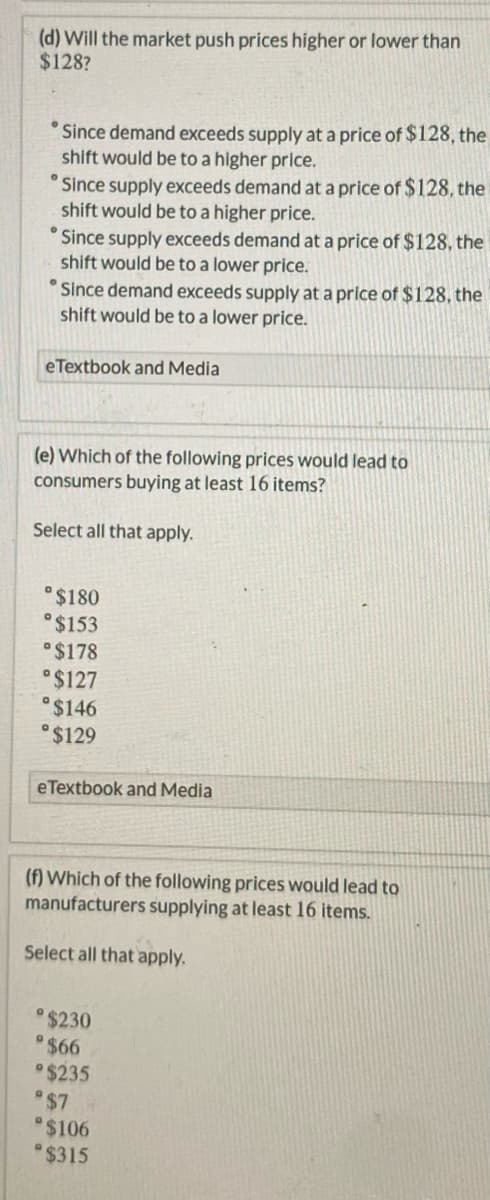One of the tables below represents a supply curve; the other represents a demand curve. Table 1 p ($/unit) 180 165 153 143 129 126 118 12 16 20 24 28 q (quantity) 4 8. Table 2 p ($/unit) 4 32 66 109 166 230 314 q (quantity) 4 8 12 16 20 24 28 (a) Which table represents which curve? Why? Table 1 is the demand curve since as price increases the quantity sold decreases, and Table 2 is the supply curve because while the price increases, the quantity supplied increases. Table 1 is the supply curve because while the price increases, the quantity supplied decreases, and Table 2 is the demand curve since as price increases the quantity sold increases. °Table 1 is the demand curve since as price increases the quantity sold increases, and Table 2 is the supply curve because while the price increases, the quantity supplied decreases. °Table 1 is the supply curve because while the price increases, the quantity supplied increases, and Table 2 is the demand curve since as price increases the quantity sold decreases. eTextbook and Media (b) At a price of $128, approximately how many items would consumers purchase? items eTextbook and Media (c) At a price of $128, approximately how many items would manufacturers supply? items eTextbook and Media
One of the tables below represents a supply curve; the other represents a demand curve. Table 1 p ($/unit) 180 165 153 143 129 126 118 12 16 20 24 28 q (quantity) 4 8. Table 2 p ($/unit) 4 32 66 109 166 230 314 q (quantity) 4 8 12 16 20 24 28 (a) Which table represents which curve? Why? Table 1 is the demand curve since as price increases the quantity sold decreases, and Table 2 is the supply curve because while the price increases, the quantity supplied increases. Table 1 is the supply curve because while the price increases, the quantity supplied decreases, and Table 2 is the demand curve since as price increases the quantity sold increases. °Table 1 is the demand curve since as price increases the quantity sold increases, and Table 2 is the supply curve because while the price increases, the quantity supplied decreases. °Table 1 is the supply curve because while the price increases, the quantity supplied increases, and Table 2 is the demand curve since as price increases the quantity sold decreases. eTextbook and Media (b) At a price of $128, approximately how many items would consumers purchase? items eTextbook and Media (c) At a price of $128, approximately how many items would manufacturers supply? items eTextbook and Media
Calculus: Early Transcendentals
8th Edition
ISBN:9781285741550
Author:James Stewart
Publisher:James Stewart
Chapter1: Functions And Models
Section: Chapter Questions
Problem 1RCC: (a) What is a function? What are its domain and range? (b) What is the graph of a function? (c) How...
Related questions
Question

Transcribed Image Text:One of the tables below represents a supply curve; the
other represents a demand curve.
Table 1
p ($/unit) 180 165 153 143 129 126 118
12 16 20 24 28
q (quantity) 4
8.
Table 2
p ($/unit) 4 32 66 109 166 230 314
q (quantity) 4 8 12 16 20 24 28
(a) Which table represents which curve? Why?
Table 1 is the demand curve since as price increases
the quantity sold decreases, and Table 2 is the
supply curve because while the price increases, the
quantity supplied increases.
Table 1 is the supply curve because while the price
increases, the quantity supplied decreases, and
Table 2 is the demand curve since as price increases
the quantity sold increases.
°Table 1 is the demand curve since as price increases
the quantity sold increases, and Table 2 is the supply
curve because while the price increases, the
quantity supplied decreases.
°Table 1 is the supply curve because while the price
increases, the quantity supplied increases, and Table
2 is the demand curve since as price increases the
quantity sold decreases.
eTextbook and Media
(b) At a price of $128, approximately how many items
would consumers purchase?
items
eTextbook and Media
(c) At a price of $128, approximately how many items
would manufacturers supply?
items
eTextbook and Media

Transcribed Image Text:(d) Will the market push prices higher or lower than
$128?
Since demand exceeds supply at a price of $128, the
shift would be to a higher price.
Since supply exceeds demand at a price of $128, the
shift would be to a higher price.
Since supply exceeds demand at a price of $128, the
shift would be to a lower price.
° Since demand exceeds supply at a price of $128, the
shift would be to a lower price.
eTextbook and Media
(e) Which of the following prices would lead to
consumers buying at least 16 items?
Select all that apply.
°$180
°$153
$178
°$127
$146
°$129
eTextbook and Media
(f) Which of the following prices would lead to
manufacturers supplying at least 16 items.
Select all that apply.
$230
$66
$235
$7
$106
$315
Expert Solution
This question has been solved!
Explore an expertly crafted, step-by-step solution for a thorough understanding of key concepts.
This is a popular solution!
Trending now
This is a popular solution!
Step by step
Solved in 3 steps with 3 images

Recommended textbooks for you

Calculus: Early Transcendentals
Calculus
ISBN:
9781285741550
Author:
James Stewart
Publisher:
Cengage Learning

Thomas' Calculus (14th Edition)
Calculus
ISBN:
9780134438986
Author:
Joel R. Hass, Christopher E. Heil, Maurice D. Weir
Publisher:
PEARSON

Calculus: Early Transcendentals (3rd Edition)
Calculus
ISBN:
9780134763644
Author:
William L. Briggs, Lyle Cochran, Bernard Gillett, Eric Schulz
Publisher:
PEARSON

Calculus: Early Transcendentals
Calculus
ISBN:
9781285741550
Author:
James Stewart
Publisher:
Cengage Learning

Thomas' Calculus (14th Edition)
Calculus
ISBN:
9780134438986
Author:
Joel R. Hass, Christopher E. Heil, Maurice D. Weir
Publisher:
PEARSON

Calculus: Early Transcendentals (3rd Edition)
Calculus
ISBN:
9780134763644
Author:
William L. Briggs, Lyle Cochran, Bernard Gillett, Eric Schulz
Publisher:
PEARSON

Calculus: Early Transcendentals
Calculus
ISBN:
9781319050740
Author:
Jon Rogawski, Colin Adams, Robert Franzosa
Publisher:
W. H. Freeman


Calculus: Early Transcendental Functions
Calculus
ISBN:
9781337552516
Author:
Ron Larson, Bruce H. Edwards
Publisher:
Cengage Learning